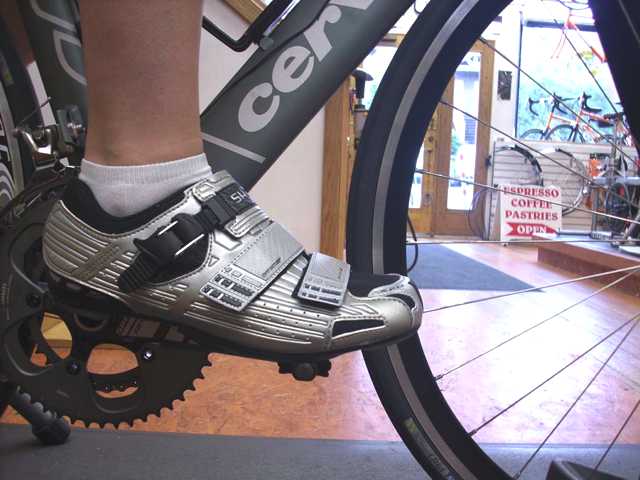
650c vs. 700c wheels
Small Problem, Big Compromises
Why Compromise? Well, sometimes you just have to.
If you ride a modern bicycle with a top tube shorter than 54cm, and the wheel size is 700c, you're already compromising. This article is to inform you of the compromises that are made throughout the bicycle industry when designing bicycles for riders under 5' 5". It is very technical, and ventures into eye glazing geometries. If you read it well, and understand it, you will be more educated in the subject of bicycle design than most folks who actually work in the bicycle industry. My goal is to help the more petite cyclists among us make an educated decision based on physics and truth. Along the way, I've linked to some information that will dispel the myths that have been regurgitated for years in bike shops and magazine articles.
The quick gist of the article for those who don't need massive amounts of info
Who this article is for:Although they can be made to look normal, 700c wheels on a small bike always results in one or more unavoidable compromises:
- The rider ends up with way too much reach to the handlebars
- The rider ends up with a dangerous amount of toe strike
- The bike is designed with poor handling characteristics
- The bike pushes the rider too far forward, resulting in knee pain
- There are not as many tire choices available to purchase
- Most shops ignore 650c wheels, so it's hard to find a 650c tire in small towns or while touring
- You have to listen to your tall friends say "why don't you ride big wheels?"
Obviously if there were no downside to 700c on every bike, then that's all we would offer. But, there are several drawbacks, and that's why we offer 650c wheels as an option for smaller bikes.
Oh yeah, if someone at a bike shop tells you that 650c wheels are slow (it happens all the time), ask them if you can test ride one of their slow 650c wheel bikes to see for yourself. Chances are, they don't have any, and probably have never even ridden one. Why would they have ridden a 650 bike if they are over 5'4" tall? If you've been told that small wheels are slow, and you're concerned about the effects of smaller wheel size on overall speed, read this.
Now, maybe you want to really understand the subject before you commit? Maybe you're the type that needs to arm yourself with some technical facts before you brave the conversation with 'the bike expert'. For those of you who really want to have a grasp on the subject, I've written more....a lot more.
- Anyone who is under 5' 5" tall (especially women), has long legs, and is shopping for a bicycle.
- Anyone who is advising someone who is under 5' 5" tall about bicycles and what to look for when selecting the proper size.
- Anyone who likes to read nitty gritty details from the mind of a crazed bicycle frame designer who's spent his entire adult life designing bicycles.
Terms you'll want to understand for this article:
- Fork Rake - Offset that places the fork ends ahead of the steering axis
- Head Tube Angle - The angle that the frame holds the fork at in relation to the ground (same as steering angle)
- Trail - The distance that the axle trails the steering axis intersection with the ground
- Effective Top Tube Length - The measurement from the center of the seat post to the center of the head tube when measured level
- Reach to Bars - Distance from center of seat to center of handle bar stem
- Proper Knee Alignment - Adjustment to ensure that your knee is centered over the pedal spindle
- Seat Tube Angle - The angle of the seat tube in relation to the ground
- Toe Strike - How much of the foot interferes with turning the front wheel
Today's subject: 650c vs. 700c wheels on smaller bikes
Disclaimer: I'm not trying to sell anyone on a specific wheel size, so realize as you read this article, we are happy to build any size bike with any size wheel. I just want to show why we offer smaller wheels for those who need smaller bikes. We build small bikes with 700c wheels all the time as some people are willing to accept the performance compromises that are unavoidable.
If you're the Cliffs Notes type....
.....and would rather just read a quick synopsis of the gymnastics it takes to put big wheels on small bikes (with lots of big pictures), you can do that here. I'm warning you now, continuing on this page is a lot reading, numbers, technical specs, etc... So, don't say I didn't warn you.
Bike Industry Mis-information
There is a lot of mis-information that is spread throughout the cycling industry about bigger wheels and smaller wheels. There are reasons for this, but this article is about why we do what we do. If you want to delve further into the mis-information I go into that here. For those that have already heard it, and just want to get educated on the subject, read on.
Good Design
A smaller wheel allows us to produce a shorter reach frame with the proper head tube angle for good control while at the same time minimizing any, if not all, toe strike. Using a 700c wheel on a bike with an effective top tube of less than 53cm requires design gymnastics (or in some cases, cheating a little) to keep this from happening. Design gymnastics result in improperly fitted bikes, or bikes that handle poorly.
In the 1980's smaller high performance bikes had 700c wheels. What happened?
The Carbon Age - Now that carbon forks are the norm on just about all competition bikes, they must be purchased from manufacturers who do not offer products with rakes required to accommodate really slack head tube angles. If we could custom make carbon forks one at a time, the way we used to make steel forks, then we could pull this off, and our jobs would be easier.
Trail Mix
Something that most people don't realize (including many who work in bike shops), is that there are good reasons for the head tube (steering) angle and fork rake as they relate to the handling characteristics of your bicycle. They are entwined with each other, and when one changes, so must the other. The trail number is dependent upon the combination of the two, and ignoring it will result in a bicycle that doesn't handle properly. The desired trail number for most purposes is 60mm or somewhere very close to it.
If you want to have some real fun, ask your bicycle salesperson "what's the trail on this bike?". It's a good way to determine the experience level of your salesperson.
Why did steel forks work better?
Steel forks offer much more flexibility for bicycle design. Years ago (1990 and before), we built lots of small bikes with 700c wheels and steel forks. We could change the head tube angle to a more 'slack' degree to move the wheel further out in front of the rider and then build the fork with more 'rake' to accommodate proper handling. The more 'slack' the head tube angle, the more 'rake' is required in the fork to maintain the appropriate 'trail' number of 60mm. The added rake moved the wheel out even further.
The very best way to put a 700c wheel on a smaller bike in 2012 is the same way that we used to do it in the 1970's and 1980's.....use a steel fork. By using a steel fork, we can keep the handling characteristics acceptable, and still build to the proper fit and knee angle.
The things I've seen:
Smaller bikes with 700c wheels and modern carbon forks have been made by many manufacturers, and I've probably seen them all in the repair shop. The compromises used are many. Here's a list of the compromised designs I've seen:
Really bad option: No compromise, completely ignore proportions
Some manufacturers don't even pretend. They simply make the small frames with a 54cm top tube, just like their bigger frames. So the reach to the handlebars for a 5' tall rider is the same as the 5'8" rider. Many women have ridden this way most of their lives, and they think bicycles just have to be uncomfortable.
I actually appreciate this approach simply because it doesn't pretend to be something it's not. This will provide the proper stand-over height, but a shorter rider's reach to the bars will be a long trip and a very uncomfortable ride (sore neck, back, arms, shoulders, etc.). Many shorter riders know what I'm talking about as they've never been offered a proper fitting bicycle for most of their life.
Now, if you're of smaller stature or need a top tube length less than 54cm, and you want your bike to fit right, there's a number of compromises that you can choose from. Some of these compromises are much better than the others, and some are meant to fool you.
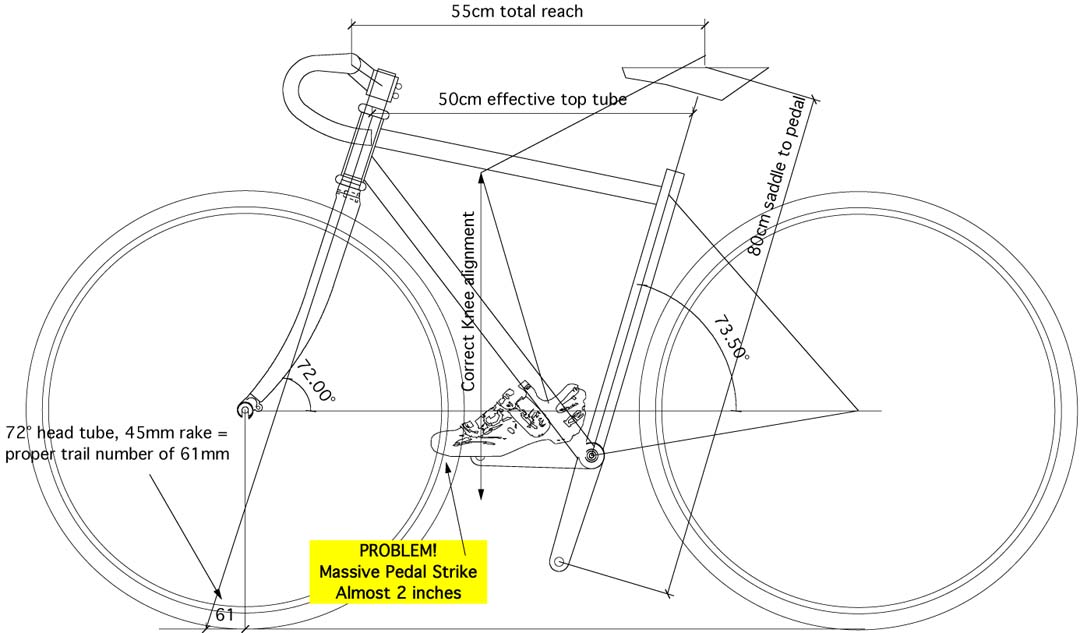 700c Compromise 1.) I call this one Wipe-out
700c Compromise 1.) I call this one Wipe-outBelieve it or not, there are manufacturers that say 'toe-strike' is not an issue. So, they just build the small bikes to the same handling characteristics as the large bikes. 60mm of trail, 72 degree head tube angle, 40 ~ 45mm or fork rake, 73.5 degree seat angle, 50cm top tube, and toes be dammed. Massive toe strike like the photo shown above in this article is common place with some major race bike manufacturers.
This picture is one I took when the customer brought the bike in because of crash damage. He didn't know why he crashed, he only know that he had swerved to miss a car door that was opened suddenly in front of him. I'll bet you can figure out how he crashed. We quit offering bikes built with massive toe-strike because of our money back guarantee. So many people who thought it would be fine, decided that they were not fine with a lot of toe strike and returned the bicycle to us for a complete refund. Nothing speeds up design upgrades like a money back guarantee I'll tell you!
I urge you to check any bike that you are considering purchasing for acceptable level of toe-strike before you buy it. A 15 minute test ride won't do either. If you're going to accept a bunch of toe-strike, you should ride the bike on your regular route a few times before you buy it. As far as I know, we are the only manufacturer who will buy back a bike that the customer is not satisfied with. With most manufacturers, you bought it, it's yours! There are a lot of women and shorter riders out there that have listed a bike on Craigslist after discovering that they were afraid to ride it because of toe-strike.
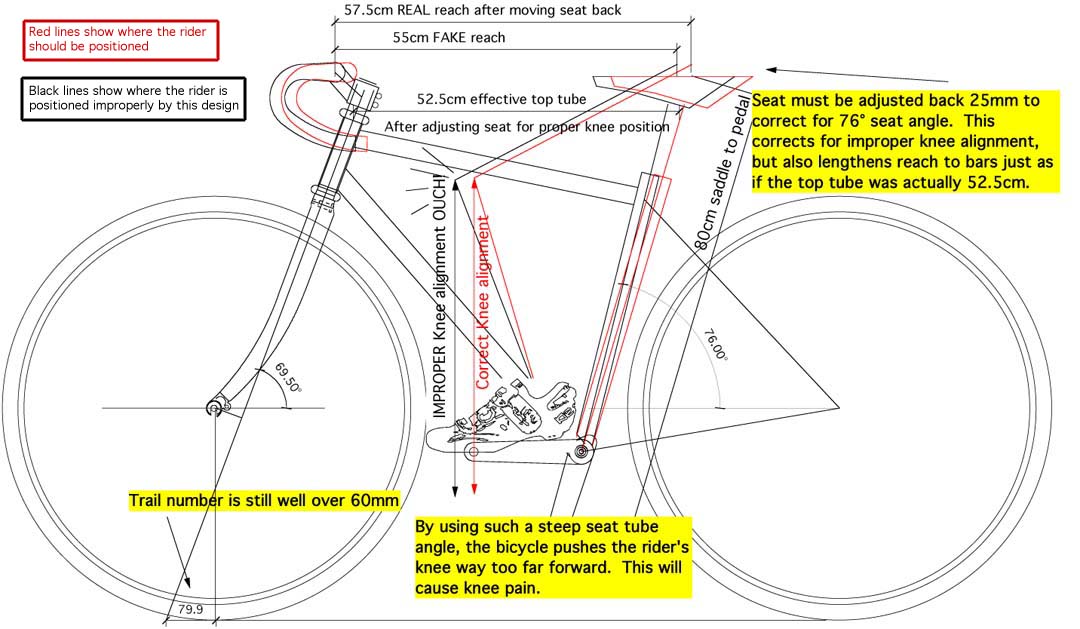 700c Compromise 2.) Resort to Trickery:
700c Compromise 2.) Resort to Trickery:Here's a tricky one. If a bike has a modern carbon fork, a 70 degree head tube angle, a top tube length of 50cm, no toe strike, fairly decent trail of 79mm, and 700c wheels, has the company found the magic formula? No. They have artificially shortened the top tube by making the seat tube angle really steep. What does this mean for the rider? Really sore knees, or the seat pushed all the way back on the rails in order to get the knees in the right pedaling position. Once the seat is pushed back on the rails to accommodate for thigh length, the reach to the bars becomes the same as if the top tube were 53 or 54cm, and the rider is just as uncomfortable. Why do this at all? To list a 50cm top tube in the catalog. Many, many manufacturers pull this stunt. I call this misleading:-(
Result - This one's really not a compromise at all. You just end up with a bad fit, and bad design. Same as Really bad option number 1 with a little knee pain thrown in as an extra treat. Discomfort and pain always results in slower riding, and that's one thing that everyone can agree on.
Important Note: Make absolutely sure that your salesperson uses a plumb line on your knee to ensure proper knee alignment. If they don't use a plumb line, then leave without purchasing the bike as you are not dealing with an experienced bicycle fitter. If the bike you are riding has an extremely steep seat angle, chances are you'll need a lot of attention to your knee position. I strongly recommend several rides before committing to a bike with a steep seat angle. A 15 minute test ride will not be long enough for any knee issues to arise.
700c Compromise 3.) Sacrifice performance:
 If the head tube angle is made very slack, say 68 degrees or less, that will usually be enough to get the 700c wheel out of the way of the foot of most people who need a top tube of less than 53cm, even with a modern carbon fork. "Why not just do that?" you ask? Well, remember 'trail'? In short, if a bike has a very slack head tube angle, but not enough rake in the fork, the steering is affected in a very negative way. It shoots up to over 100mm on some expensive custom bikes. In other words, you won't be been doing the 'look ma, no hands' trick unless it's followed by the 'look ma, no teeth' trick.
If the head tube angle is made very slack, say 68 degrees or less, that will usually be enough to get the 700c wheel out of the way of the foot of most people who need a top tube of less than 53cm, even with a modern carbon fork. "Why not just do that?" you ask? Well, remember 'trail'? In short, if a bike has a very slack head tube angle, but not enough rake in the fork, the steering is affected in a very negative way. It shoots up to over 100mm on some expensive custom bikes. In other words, you won't be been doing the 'look ma, no hands' trick unless it's followed by the 'look ma, no teeth' trick.This compromise will result in a bike that handles like a 1966 Ford pickup with no power steering. The bike will be hard to control in tight corners, and just not as much fun as it should be. Having to put so much energy into steering creates pains in the neck, hands, shoulders, and arms. This is all the opposite of what Rodriguez philosophy of cycling is about.
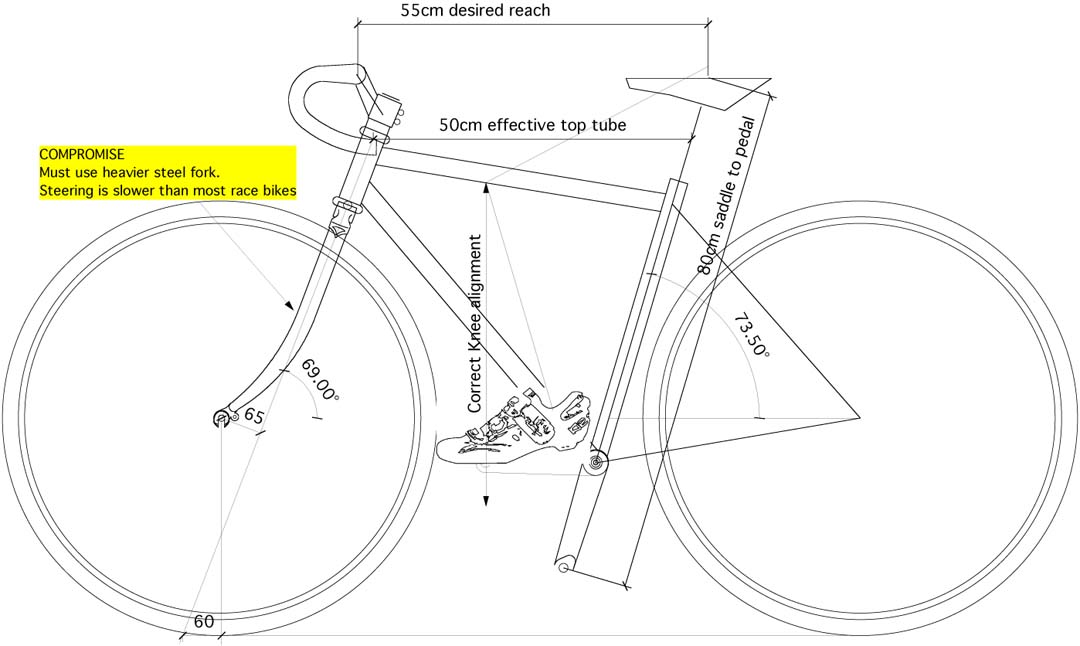 700c Compromise 4.) Sacrifice weight:
700c Compromise 4.) Sacrifice weight:Let's go old school, and use a steel fork like in the 1980's. This is a pretty good option if you really want to use 700c wheels on a smaller bike. We can build a bike just like we used to in the 1980's, and put lots of rake in the fork to match the slack steering angle to keep the trail number at 60mm. Although the steel fork is heavier than modern carbon forks, the bike will be comfortable to ride and you won't hit your foot on the wheel when you try to turn. The handling of a bike like this is still not what most people are after on race bikes, as the 'front center number' (another article) is more like a 1980's Peugot, but the bike is safe.
This compromise is the one we recommend for smaller riders wanting big wheels. If you want to feel a bike set up this way in comparison to a 650c wheel bike, just ask and we'll let you try them both on extended test rides.
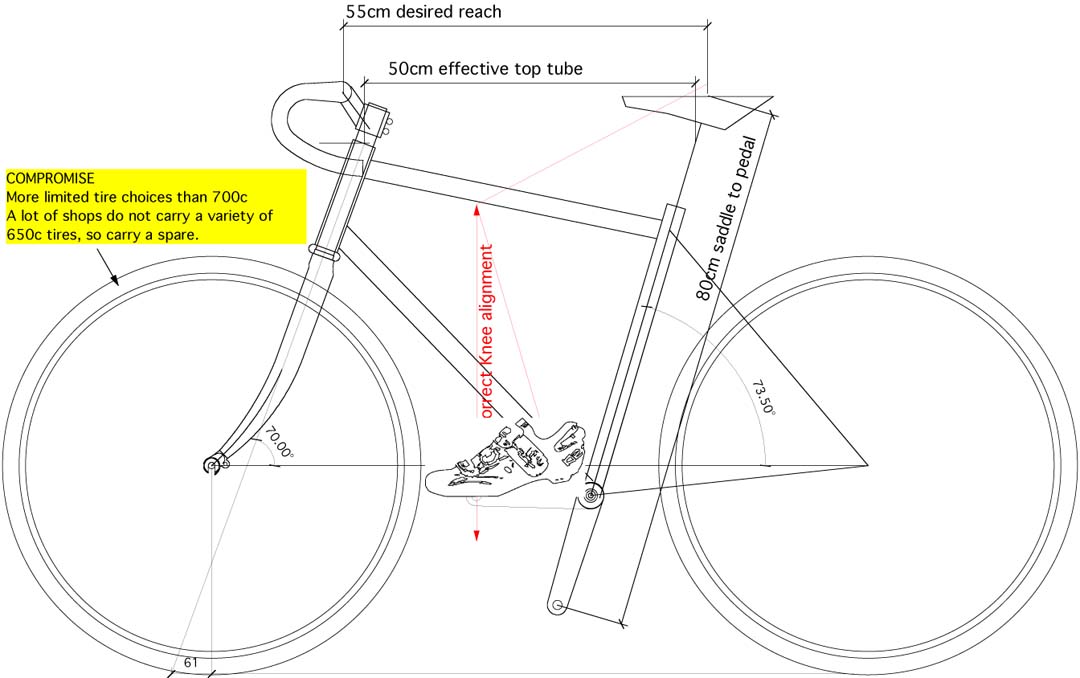 650c Compromise 5.) Sacrifice convenience:
650c Compromise 5.) Sacrifice convenience:Here's an idea....why not go to the extra expense and use a proportional sized wheel on the bikes that are smaller? This is the method that companies use when they are trying to provide the best fitting bikes without compromising safety or good performance. It also costs more for the manufacturer, and requires commitment and understanding of their customer's needs. 650c wheels provide a world of design upgrades to the shorter rider, and should not be mis-understood.
That being said, there is a drawback to them. The drawback is that there are fewer tire choices for 650c, and there are not a lot of shops that stock 650c tires. So, you'll want to have a spare if you're on a long tour. Other than that, there are no drawbacks to a 650c vs. a 700c tire.
Now, I realize that some customers want special tires or rims that are only available in 700c, and are willing to sacrifice the weight or performance of proportional wheels, and I have no argument with that. We're happy to, and do build a lot of smaller bikes with 700c wheels. I do have an argument with shops that say things like "smaller wheels are slower", or "there's no compromise in it" when science and physics prove differently. Facts are stubborn things I guess.
Alright! Women and shorter riders, you make the decision. Do you want the same comfort, control and performance as the taller riders get? Or, would you rather have the same wheel size that the taller riders get? It doesn't matter to us, as long as you are making an educated decision.
WOW! Are you still reading this? If so, you've probably got more questions. I'm happy to answer any of them regarding this issue. I'm dumbfounded as to why some folks out there almost get angry about this subject, but it seems like they do. Back in the days before 650c wheels were common, we used to use 24" wheels for small bikes. Imaging how mad that would make those people :-) Anyway, shoot me an email if you have any questions about this article. It's a technical article, and really could be a book if I went into every aspect of the issue. Suffice it to say, that if you grasp the facts in this article, you'll be way ahead of many folks I meet in this industry.
Dan - 2012

